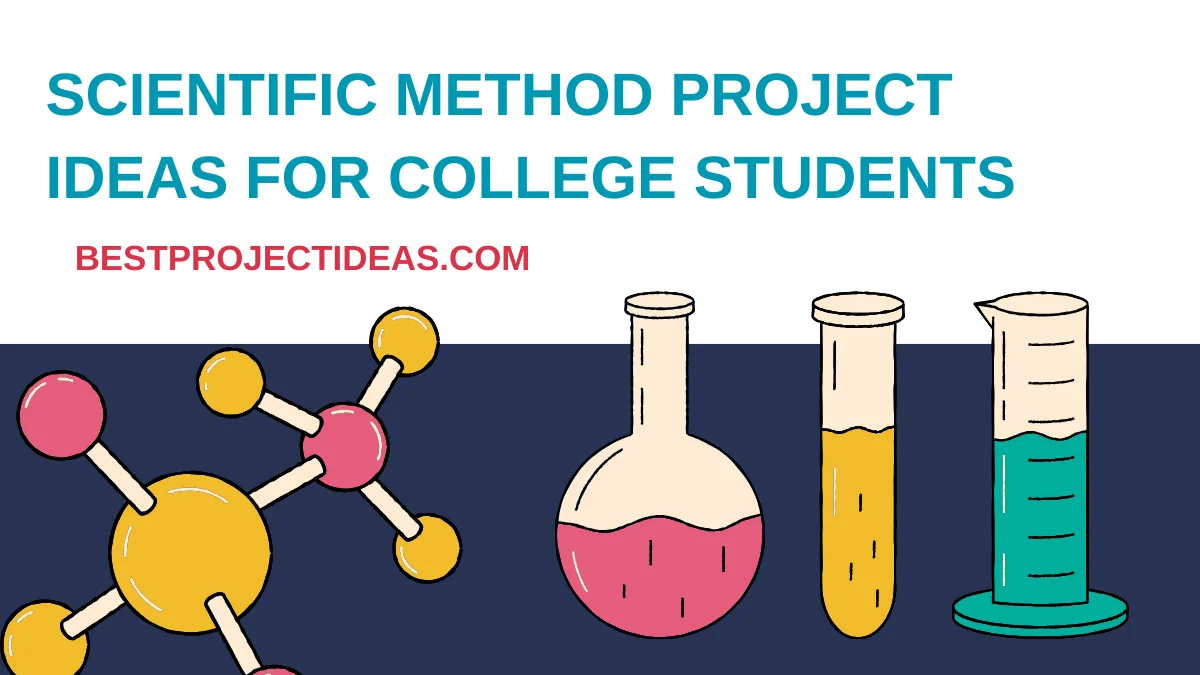
College students need hands-on learning to really learn how science works in the real world. They also build teamwork, lab skills, and data literacy. Scientific method project ideas for college students provide a simple way to turn classroom lessons into real experiments and studies.
These projects teach students to ask clear questions, make predictions, test ideas, and examine results—the basic skills scientists use every day. Whether you study biology, chemistry, physics, or environmental science, doing a science project helps you think like a researcher and solve problems step by step.
Finishing a project that follows the scientific method gives you experience beyond textbooks and prepares you for careers in science. This hands-on way of learning makes classes more interesting and helps you gain confidence in doing real research.
MUST READ: Top 25 Blockchain Project Ideas 2026-27
Scientific Method Project Ideas For College Students
Here are the latest Scientific Method Project Ideas For College Students:
Biology and Health
- Sleep and Memory: Test if getting eight hours of sleep helps students remember words better than six hours.
- Caffeine and Typing: Check if drinking coffee makes people type faster or causes them to make more mistakes.
- Music and Heart Rate: See if listening to fast rock music makes a heart beat faster than listening to slow jazz.
- Germs on Phones: Swab different cell phones to see which brands or cases hold the most bacteria.
- Hand Sanitizer Test: Compare three different sanitizer brands to see which one kills the most germs on hands.
- Exercise and Math: Measure if running for ten minutes helps students solve math problems faster right after.
- Sugar Crash: Record how energetic a person feels every hour after eating candy versus eating an apple.
- Blue Light Impact: Test if looking at a phone screen right before bed makes it harder to fall asleep.
- Plant Music: Play music for one plant and keep another in silence to see which one grows taller.
- Water Purity Check: Test tap water from different campus buildings to see which has the fewest chemicals.
Psychology and Behavior
- Plate Color and Food: Serve snacks on blue and red plates to see if the color changes how much people eat.
- Social Media Mood: Track how happy or sad students feel after scrolling through apps for one full hour.
- Witness Memory: Stage a fake event in class and ask students what they saw to check if their memory is correct.
- Fonts and Reading: Test if people read a page of text faster in Arial font compared to Times New Roman.
- Group Pressure: See if students change their answers to easy questions when the whole group disagrees with them.
- Gum and Focus: Check if chewing gum helps students get higher scores on a quick memory quiz.
- Weather and Feelings: Record the daily weather and ask students to rate their happiness to find a pattern.
- Noise and Work: Test if people finish homework faster with the TV on or in total silence.
- Smiling Effect: See if smiling at strangers makes them more likely to help you pick up a dropped item.
- Brand Taste Test: Blindfold people to see if they can actually taste the difference between cheap and expensive soda.
Environment and Nature
- Rotting Plastic: Bury different “eco-friendly” forks to see which one breaks down the fastest in dirt.
- Solar Box Cooker: Build three boxes with different linings to see which one cooks an egg the quickest.
- Air Dirt Sensors: Place sticky cards in a park and a parking lot to count how much dust is in the air.
- Cleaning Water: Build a filter using sand and rocks to see how clear it makes dirty pond water.
- Vinegar Rain: Water plants with vinegar mixtures to see how much acid it takes to kill the leaves.
- Keeping Ice Cold: Wrap ice cubes in wool, cotton, and foil to see which material keeps the ice frozen longest.
- Fast Compost: Mix paper, food scraps, and leaves to see which combination turns into soil the fastest.
- City Starlight: Count how many stars you can see in the city center versus a quiet country road.
- Oil Spill Cleanup: Test feathers, human hair, and sponges to see which material soaks up oil from water best.
- Salty Seeds: Plant seeds in salt water and fresh water to see how salt stops them from growing.
Physics and Engineering
- Pasta Bridges: Build bridges out of spaghetti and glue to see which shape holds the most weight before breaking.
- Cold Batteries: Put batteries in the fridge and a warm room to see which ones last longer in a flashlight.
- WiFi Blockers: Test materials like aluminum foil and wood to see which one stops WiFi signals the most.
- Parachute Shape: Drop weights with square and round parachutes to see which one lands more gently.
- Paper Plane Design: Fold planes with different wing sizes to see which design flies the farthest distance.
- Blocking Sound: Line a box with egg cartons and foam to see which material blocks sound better.
- Sliding Friction: Slide a wood block on carpet, tile, and ice to measure how hard you have to push it.
- Hot Magnets: Heat a magnet to see if it can still pick up as many paperclips as a cold magnet.
- Solar Angle: Tilt a solar panel at different angles to see when it creates the most power from the sun.
- Catapult Throw: Change the arm length of a catapult to see how it changes the distance a ball flies.
Chemistry and Food Science
- Juice Vitamin C: Test fresh orange juice and store-bought juice to see which one has more Vitamin C.
- Big Reactions: Change the amount of vinegar in baking soda to see what mix makes the biggest foam explosion.
- Rust Speed: Put nails in water, saltwater, and soda to see which liquid makes iron rust the fastest.
- Cookie Fats: Bake cookies with butter and oil to see which fat makes the cookie softer or crunchier.
- Milk in Light: Leave milk in a dark box and under a lamp to see which one goes bad faster.
- Stain Fighting: Test three different soaps on ketchup stains to see which one cleans the fabric best.
- Melting Ice: Put salt and sugar on ice cubes to see which powder melts the ice quicker.
- Vegetable Dye: Boil spinach and beets to see which vegetable dyes a white shirt a stronger color.
- Popcorn Storage: Store popcorn in the freezer and the cupboard to see which batch pops more kernels.
- Drink Energy: Use a sensor to measure if sports drinks carry more electricity than plain tap water.
MUST READ: 25 Recycle Material Project Ideas 2026-27
Summary
Scientific Method Project Ideas For College Students provide practical ways to learn how research works in real settings. These projects guide students through the main steps of scientific thinking, from posing questions to testing hypotheses and recording results. College students can pick projects across biology, chemistry, physics, or environmental science to match their interests.
Using the scientific method builds skills that matter beyond class and ready students for careers in research, health care, and technology. Completing projects helps students gain confidence in solving problems, evaluating information, and adding to scientific knowledge. This hands on approach makes learning more active and helps students see how science connects to daily life and future jobs. They also encourage teamwork, clear communication, and careful record keeping that many employers highly value today.

